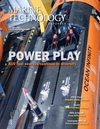
Page 24: of Marine Technology Magazine (July 2022)
Read this page in Pdf, Flash or Html5 edition of July 2022 Marine Technology Magazine
ROVs & Hybrids
S ROV END ER OVER
An illustration of the Isurus
ROV monitoring an offshore wind cable lay operation.
Oceaneering
B C KY ELIA ONOWE une 8, 2022, marked this year’s United Nations (UN) change be implemented for the oceans need without further
World Ocean Day—as well as 30 years since the idea disturbance? The world of remotely operated and autonomous was proposed and 14 since being adopted of? cially underwater vehicles (ROVs and AUVs, respectively) may by the UN. This year’s hybrid conference highlighted yield some ideas.
J the theme, “Revitalization: Collective Action for the
Ocean,” inspired by a global urgency to create a new, healthier FAN OF OFFSHORE WIND coexistence. Earth’s oceans are reaching a tipping point and as Oceaneering is a Texas-based provider of engineered prod- time passes, so do opportunities to understand the deep blue ucts and services for industries on land, in the air and in the sea and mitigate the effects of centuries of misuse. The pres- sea. Its Subsea Robotics Program features multiple ROVs, sure of time, though, is not lost on those enamored by and including Isurus, a work-class vehicle for offshore wind. Isu- dependent on the ocean; as such, research, expeditions, policy rus is designed to complete tasks in regions speci? c to off- and technology have all advanced notably in recent years. shore renewables, where water is shallower and currents are
One challenge facing a healthy and plentiful oceanic future stronger. “Traditional work-class ROV systems were designed is the undeniable anthropogenic in? uence on the climate. for deep-water environments and for operating more power-
Consumption, from natural resources to consumer goods, has ful tooling,” explains Nick Rouge, Subsea Robotics program left the planet dependent on dirty processes and commodities, manager. “These systems struggle to maintain position in tidal as well as weighed down by mountains of lingering trash. Po- currents that exceed 1-1.5 knots. Working with our clients, we tential solutions for environmental crises across the board are identi? ed that a hydrodynamic form factor for a work-class not new, yet more needs to be done and quicker. Given that ROV could signi? cantly increase its speed in water and enable humans leave their mark wherever they go, how can positive projects to continue in currents exceeding 2.5 knots.” 24 July/August 2022
MTR #5 (18-33).indd 24 6/30/2022 1:02:39 PM

 23
23

 25
25
